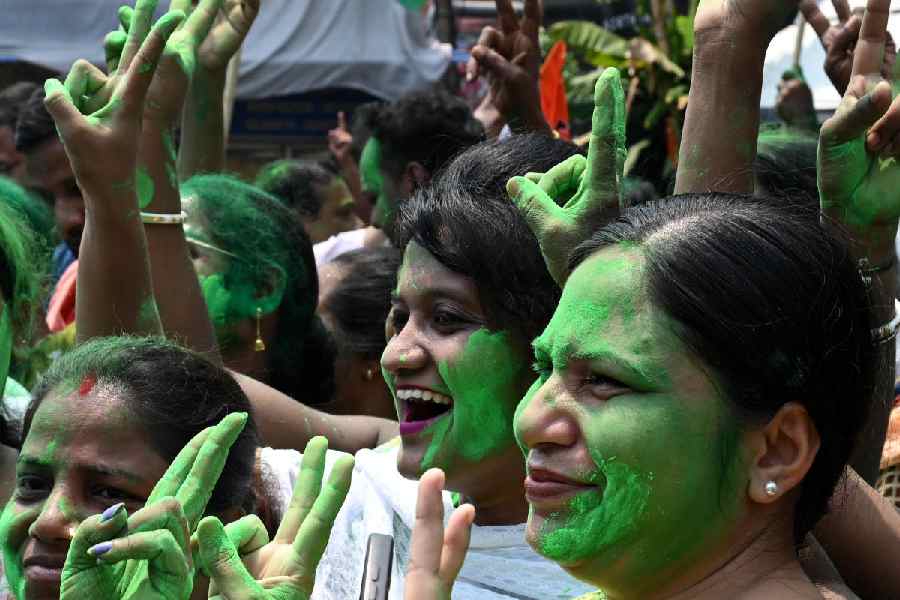The Trinamool Congress will examine the reasons for the BJP’s leads in many of the 125 municipalities and corporations in Bengal in the Lok Sabha polls and take remedial measures to improve its performance at urban centres.
“Although we won 29 out of 42 Lok Sabha seats, the result suggests that our achievement in urban areas is not satisfactory. We trailed in several civic areas where we won Lok Sabha seats. The party will certainly find out what led to less number of votes in urban areas,” said a senior Trinamool leader in Calcutta.
The BJP secured leads in around 60 per cent of the wards in 125 municipalities and corporations.
In Bolpur, where Trinamool candidate Asit Mal won by a margin of over 3.27 lakh votes against the BJP’s Piya Saha, the saffron camp got a lead of around 5,800 votes in the Bolpur town. The BJP was ahead of Trinamool in 16 out of 22 wards.
Despite the TMC winning the Bankura seat, the party trailed in 21 out of 24 wards in Bankura town. The trend followed in Jhargram municipality and Hooghly’s Chinsurah municipality, where the TMC won the Lok Sabha seats.
The trend of the BJP’s rise in vote share in urban pockets started in the 2019 Lok Sabha polls when the party bagged 18 out of Bengal’s 42 constituencies. In the 2021 Assembly polls, when the TMC got a clean sweep by winning 215 seats in the state, the voting pattern in the urban pockets was not changed. In 2021, the BJP was ahead of the TMC in 69 out of 125 civic bodies in the state.
Apart from Nadia’s Taherpur municipality, run by the CPM, the TMC has boards in all 124 civic bodies, including the Kolkata Municipal Corporation (KMC).
In this Lok Sabha polls, the BJP got leads from 45 out of 144 wards of the KMC, causing dismay for the ruling dispensation as the saffron camp had won only in three wards in the 2021 civic polls.
A source in the TMC said chief minister Mamata Banerjee had asked Calcutta mayor Firhad Hakim to examine the reason behind such results in the city.
Political observers have said the contrast between the TMC’s performance in rural and urban areas shows that people who are not dependent on different welfare schemes and benefits through direct account transfer did not vote for the ruling party in small and semi-urban pockets.
“Simultaneously, it sends a message that many urban people have voted against
poor governance and alleged corruption by the ruling dispensation,” said political scientist Biswanath Chakraborty.
Multiple TMC functionaries told this correspondent that issues related to civic amenities and leaders’ roles in municipal and corporation elections last year were responsible for the party’s pain in the urban pockets.
“The BJP has got a lead in Bidhannagar Municipal Corporation where civic polls in 2022 were marred by allegations of violence and malpractices. One of the main reasons for the BJP’s lead in many municipalities was the malpractices in the civic polls,” said a Trinamool leader.
A source in the TMC said the party had focussed on the rural vote bank in the general election as it campaigned about the denial of funds under schemes like MGNREGA and Pradhan Mantri Awas Yojna (PMAY) by the BJP-led Centre.
“Barring the poor, most urban people are less bothered about the funds spent to run rural schemes and it is also a fact that schemes like Lakshmir Bhandar are less effective in cities and towns where the average income of a family is higher compared to households in villages,” said a source in the TMC.
BJP’s chief spokesperson Samik Bhattacharya claimed that the section that played a role in opinion-making had voted for the party in the Lok Sabha polls.
“The opinion makers voted for us and that is why we got a lead from five wards in Calcutta that are part of chief minister Mamata Banerjee’s Assembly segment. The rural people also voted for us and that is why we won 12 seats in remote areas like Purulia and Raiganj,” said Bhattacharya, who is also a Rajya Sabha member.










